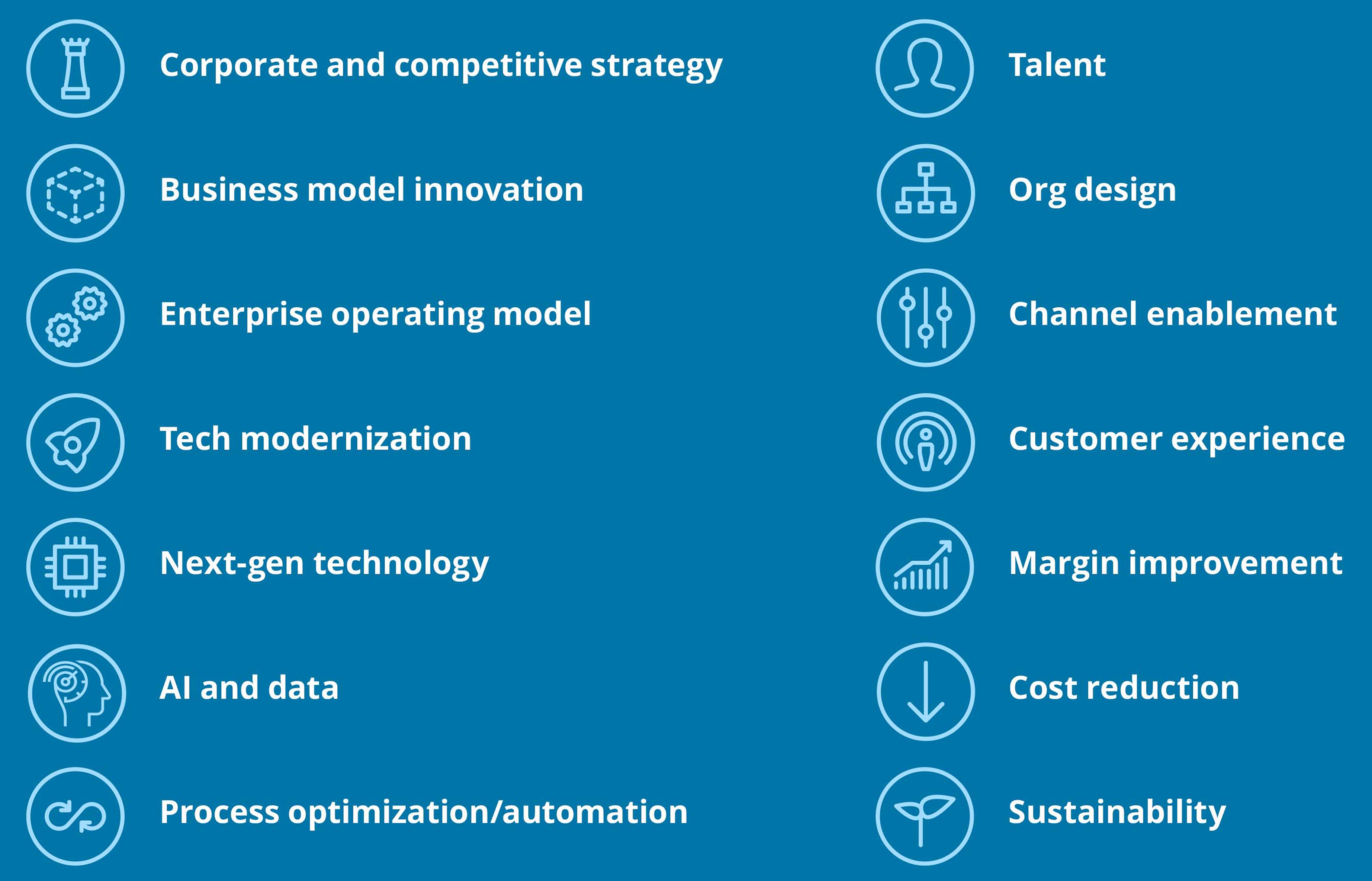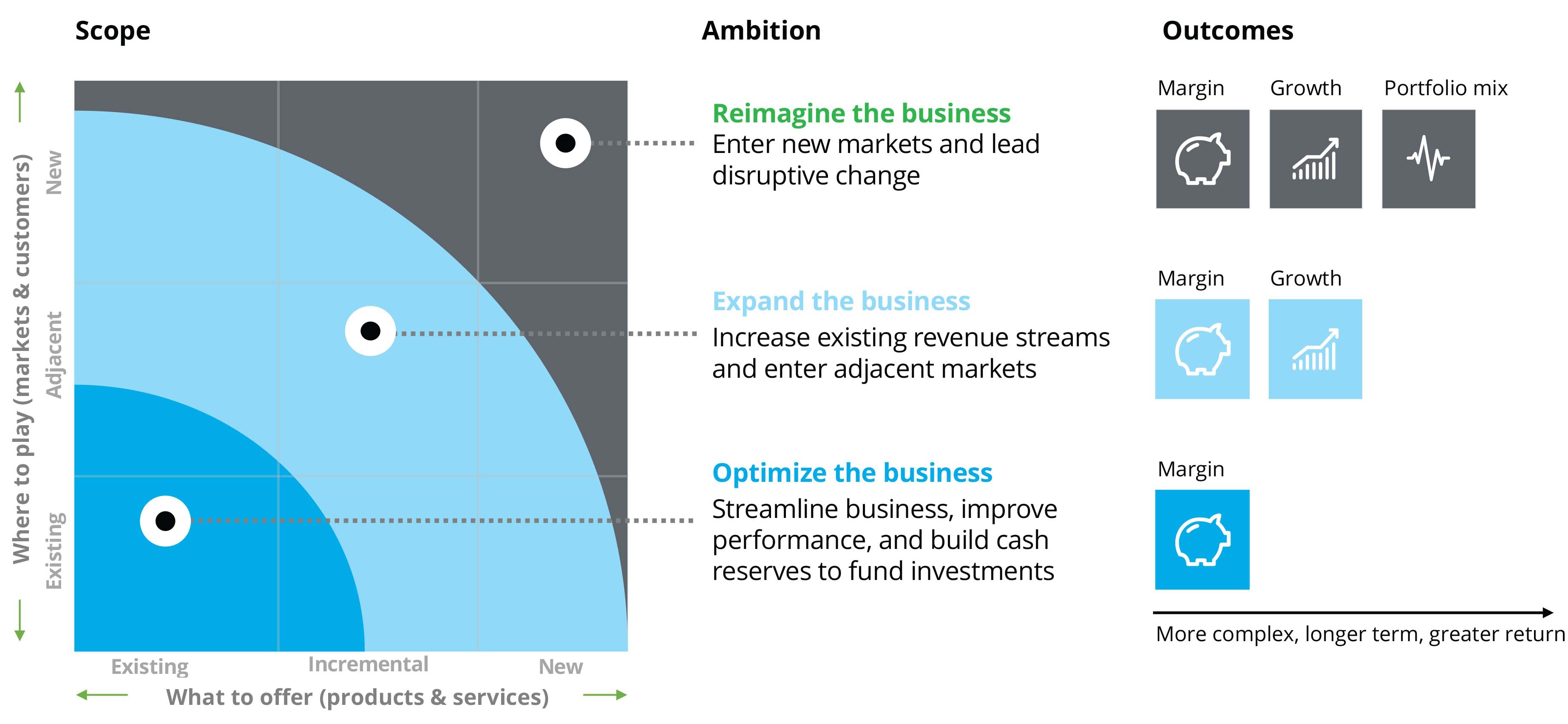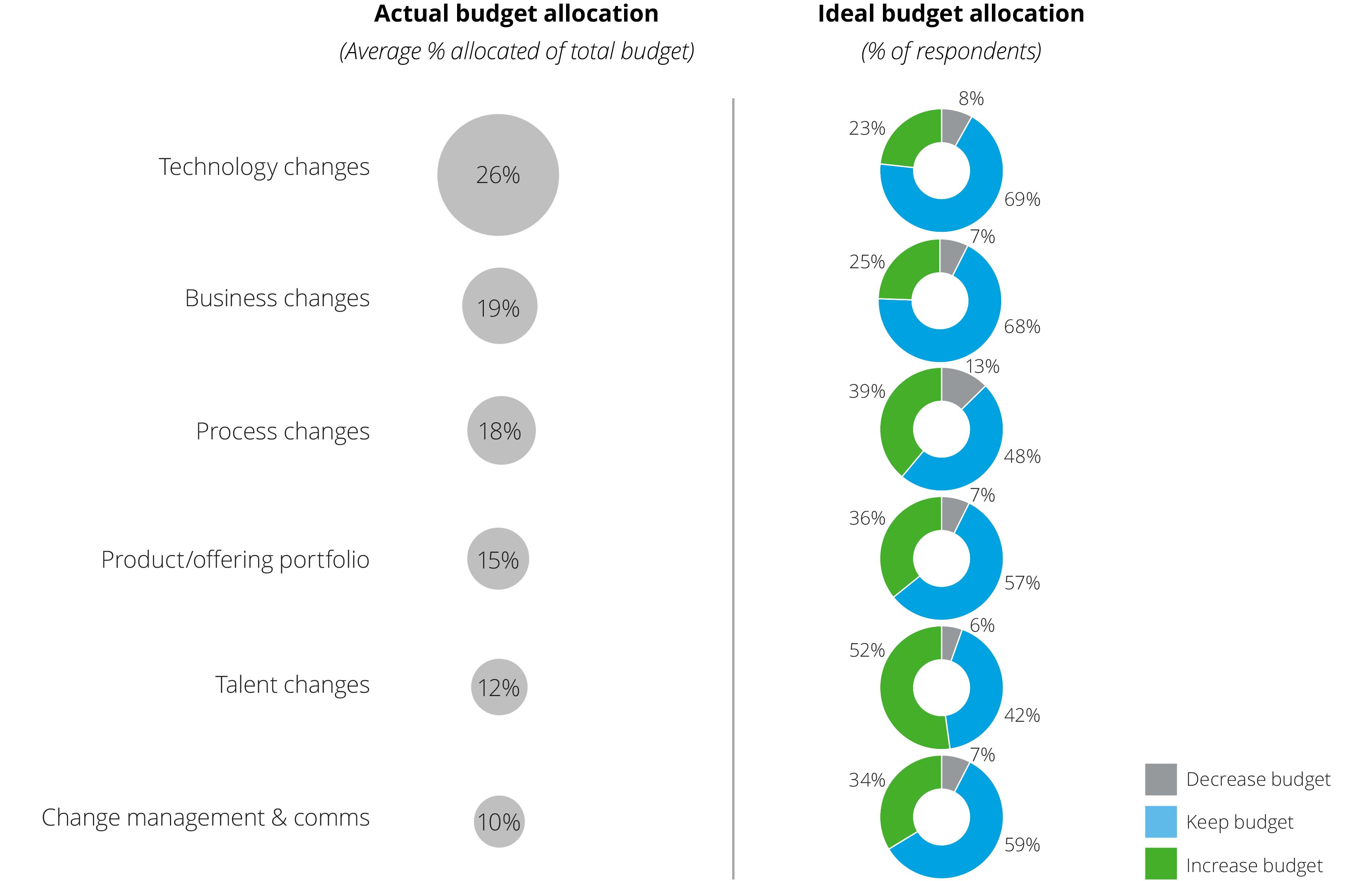Monitor Deloitte’s 2022 Chief Transformation Officer Study
Designing successful transformations

Designing successful transformations
What is transformation?
Disruptions like the ones we’ve seen over the past few years—including COVID-19, the “Great Resignation,” supply chain challenges, among others—are emerging faster than ever before. Leading companies view such societal, economic, and technological disruptions as an opportunity to transform themselves by supercharging innovation, accelerating growth, or radically simplifying operations. However, the increased frequency, uncertainty, and potential impact of such disruptions have also forced organizations to reimagine the nature of transformation.
Transformation is no longer perceived as a discrete response to individual events. Instead, it has become an enterprise capability engrained in the DNA of every organization to enable continuous and effective change. Successful organizations recognize the need for an “always-on” transformation capability. Dedicated transformation leaders (e.g., Chief Transformation Officer, VP of transformation) with a persistent transformation management office (TMO) have become increasingly commonplace in these organizations.
We’ve studied and written extensively about the benefits and characteristics of an “always-on” transformation capability. This capability is not innate to organizations but is developed—one transformation program at a time.
Monitor Deloitte’s 2022 Chief Transformation Officer (CTrO) study shares insights from more than 300 executives across a range of industries and geographies and sheds light on what it takes to design transformation programs effectively. Respondents have extensive transformation experience, with more than 75% of the group overseeing three or more enterprise transformation programs. Seventy-six percent of the group led transformations that achieved all their stated financial objectives. In this study, we lay out a comprehensive, empirical view of leading practices to maximize the probability of success of a transformation program and, as a result, help organizations develop and strengthen their transformation capability.
The state of transformation in 2022
Monitor Deloitte’s 2022 Chief Transformation Officer (CTrO) study shares insights from more than 300 transformation executives across a range of industries and uncovers what it takes to design transformation programs effectively.
of respondents have overseen three or more enterprise transformation programs
of respondents led transformations that achieved all their stated financial objectives
Designing successful transformations
Why do companies transform?
Transformation programs are bold, aspirational, and can significantly alter the trajectory of a business. They require orchestration across multiple functions, and often, the entire enterprise. Further, enterprise transformations demand a convergence across strategy, talent, processes, operations, and technology. Given that a transformation program is a stepping-stone to a robust transformation capability—which enables a sustainable competitive advantage—it’s crucial that organizations learn how to deliver such programs successfully, despite their complexity.
What are companies transforming?
Transformation is the process of companies adapting to changes in the business environment as a result of disruption. A holistic response requires adaptation across multiple dimensions of strategy, talent, operations, technology, etc. Respondents cited multiple dimensions within their transformation scope:

Given the tectonic shifts in social, economic, and environmental conditions, enterprises must develop a clear response. Transformation is the process of adapting to changes in the business environment as a result of these disruptions.
Our findings reveal three primary transformation ambitions or overarching goals.
- Optimize the business – Streamline operations, improve performance, and build cash reserves to fund investments.
- Expand the business – Increase existing revenue streams and enter adjacent markets.
- Reimagine the business – Entering new markets and lead disruptive change.
Moreover, organizations have the flexibility to pursue one, or all, of these ambitions at any point of their transformation journey.

Transformation ambition (% of respondents)
Our findings show that the most common ambition was expanding the business, such as entering adjacent markets or launching new business models (e.g., anything-as-a-service). This was followed by optimizing the business and “keeping pace” with the competition by improving operations and digitizing. Reimagining the business, such as going after an entirely new customer or market segment, came in third.
Optimize the business – Streamline complexity, improve performance and build cash reserves to fund investments
Expand the business – Increase existing revenue streams and enter adjacent markets
Reimagine the business – Enter new markets and lead disruptive change
Designing successful transformations
Which factors predict success?
While each transformation program is unique, success may be defined as meeting or exceeding the stated financial and non-financial transformation goals. Our findings indicate that there are three attributes that truly serve as the best predictors of success, regardless of transformation ambition or trigger:
- C-Suite engagement – The C-suite’s ability to set realistic expectations and incentives, designate the right people to the job, and establish a compelling transformation narrative.
- Chief Transformation Officer dedication – The time dedication and cross-functional agility of the transformation executive.
- Financial Investment – Sufficient and appropriately distributed investment.
C-Suite Engagement: Transformations require a commitment from the top levels of the organization. In fact, our study finds C-suite buy-in is one of the most accurate predictors of transformation success. However, the concept of “buy-in” can be elusive to define. According to respondents, C-suite buy-in includes setting clear expectations around timing and impact realization, committing meaningful executive time, and articulating and disseminating a “north star.”
- Setting clear expectations: Nearly 50% of executives emphasize that a sufficient time horizon to show return on investment is a critical success factor, with the tone set at the top.
- Committing meaningful executive time: On average, executives that successfully realized their transformation ambition spent 18% of their time guiding and shaping the program.
- Articulating and disseminating a 'north star': Thirty-eight percent of executives cite that a straightforward, compelling “north star” narrative is critical to success.
Chief Transformation Officer dedication: There is no replacement for having the right leader with the appropriate time and latitude to spearhead the transformation. We found that an empowered Chief Transformation Officer, one who devotes time and energy to drive the transformation forward, is a leading predictor of transformation success. What’s more, CTrO time dedication has an outsized impact compared to other financial investments. For starters, we observe that a CTrO contributing an additional 15% of their time improved the probability of success by approximately 16%. In contrast, it would likely require organizations to increase the transformation budget by about 12% to achieve a commensurate enhancement in success rate. Clearly, then, time is more effective than money in this instance.
Financial investment: Two questions consistently contemplated by CEOs and transformation executives are how much to spend and where to spend it. Investment allocation is critical and is often a complex process. While rapid decision-making about investments remains a capability that enterprises cite as an improvement opportunity, transformation executives shared lessons learned about which investments make transformations successful.
- It takes money to make money: Roughly 50% of survey respondents indicated that their organizations invested 1% to 5% of annual revenue on transformation programs, and 22% of respondents indicated an investment of 6% to 10% of annual revenue.
- Underinvesting in people and change: Ironically, transformation leaders consistently report underinvesting in talent, change management, and communications when reflecting on their investments. Fifty-two percent of respondents believe they underinvested in talent, and 34% believe they underinvested in change management and communications initiatives. Our experiences confirm that executives typically under-resourced the “softer side” of transformation programs, which often leads to downstream challenges with uptake, behavior change, confidence in the program, or clarity of vision.

Transformation budget allocation
Transformation leaders allocate the highest percentage of their total budget across the following categories:
Technology changes (e.g., architecture, implementation, managed services)
Business changes (e.g., strategy, customer experience, business model)
Process changes (e.g., automation, optimization, external advisory)
Designing successful transformations
Who leads the transformation?
The bold, aspirational nature of transformation requires big-picture thinking, while the operational nature of execution requires detail and structure. The Chief Transformation Officer/transformation executive must play multiple roles including:
- Strategist (big-picture architect)
- Operator (skilled general manager)
- Technologist (platform and tech architecture impacts)
- Controller (financial custodian)
- Change Champion (people-oriented, storyteller)
There is no universal career path to success as a CTrO. The enterprise-wide nature of transformations requires cross-functional orchestration and collaboration. Our findings indicate that the most common functional backgrounds among our respondents were information technology (IT) (25%), sales and marketing (23%), and general management (19%). This group was followed by finance (9%), product development (8%), and supply chain (6%). While functional knowledge doesn’t determine success, we find that successful CTrOs have a range of experiences, the ability to adapt and be change-oriented and navigate multiple functions effectively, given the enterprise-wide scope of the work. These leaders are self-aware enough to know their limitations, convene the right people, and delegate effectively. Finally, CTrOs balance competing needs to deliver short-term wins while sustaining success over the long term.
Time allocation of Chief Transformation Officers/transformation executives (average % of time spent in each role)
Strategist (big-picture architect)
Change champion (people-oriented, storyteller)
Operator (skilled general manager)
Technologist (platform and tech architecture impacts)
Controller (financial custodian)
Designing successful transformations
What are key steps to transformation success?
Ultimately, the stakes are always high with transformation. While every organization faces unique complexities in the program design and execution, our findings offer insights on the predictors of success and the lessons learned by transformation executives. Our key takeaways for companies starting a new transformation program, or even navigating an existing one, are to:
- Lay out a clear, concise, and forward-looking vision for the enterprise
- Commit executive time to the transformation, from the CEO and CTrO down
- Plan for a meaningful investment across multiple years
- Organize using an empowered, cross functional Transformation Nerve Center (TNC)
- Eliminate incumbency biases by engaging subject-matter experts as needed
- Over-emphasize talent vectors, including change management and communication
It’s well documented that most organizations take on transformations and that many of them fail. However, in our experience, enterprises and executive teams that embody these principles are more likely to beat the odds of transformation success—irrespective of the ambition, metrics, and desired outcomes.
Get in touch

Anne Kwan
Transformation Strategy & Design (TS&D) market offering lead, Principal, US Monitor Deloitte


